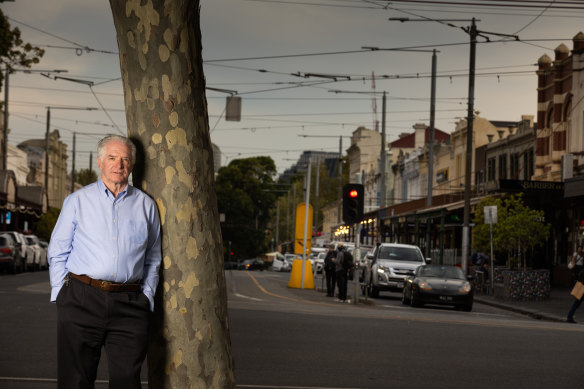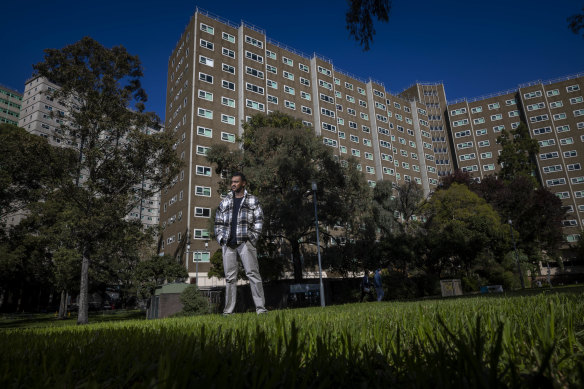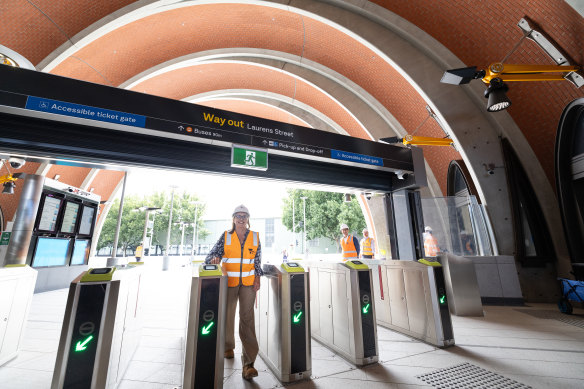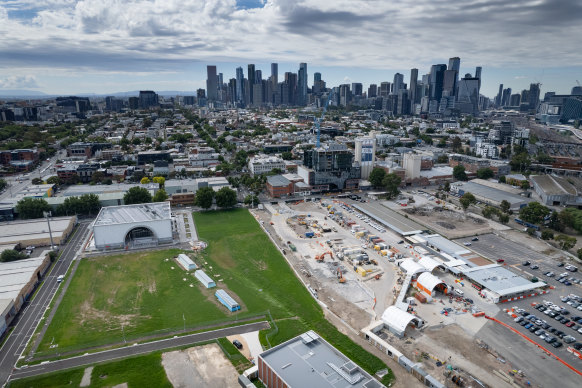This was published 8 months ago
The suburb trying to avoid the fate of Docklands as towers shoot up
North Melbourne has long been gentrified, and its mixed-income residents have always co-existed, but a windfall of government and private investment could change that.
By Najma Sambul

Kevin Chamberlin, former Melbourne lord mayor and North Melbourne resident, on Errol Street.Credit: Jason South
Standing outside his Californian bungalow in a leafy North Melbourne street, Kevin Chamberlin points to a neighbour’s home.
“When I first came here, the person who lived in this house was a labourer, now it’s occupied by a retired heart surgeon,” says Chamberlin, a former Melbourne lord mayor and a resident of North Melbourne for more than 60 years.
In that time, he’s witnessed dramatic change and a demographic shift from working class to white collar.
The proximity to the Parkville education and health precinct, the CBD and good schools has made North Melbourne attractive for families and young people. The median age of its residents is 31, which is eight years younger than the state average.
North Melbourne is now home to more paediatricians and mathematicians than any other suburb in the state, according to Australian Bureau of Statistics data.
It was in the 1980s – as the City of Melbourne placed heritage controls over North Melbourne’s Victorian and Edwardian homes – that a new wave of professionals, including doctors, teachers, and academics saw another appeal, says Chamberlin. “That’s when the gentrification really took off.”
The suburb was once a gritty industrial home to flour mills, biscuit and glass factories employing labourers and war veterans, but many factories were shut down under the economic restructuring of Australia to a higher skilled services-based economy. And as technology changed, North Melbourne’s warehouses were no longer relied on to serve the city’s ports.
That demographic trend is set to continue and accelerate under the state government’s grand Arden urban renewal vision, including high-density housing for more than 15,000 new residents and closer integration with the neighbouring Parkville health precinct.
Despite its changing economic and social character, North Melbourne has always been a suburb that’s balanced the expectations of the wealthy and working class, says long-term resident Judy, at Mr Tucker cafe on Melrose Street. “It would be a shame to see that go.”
The question for many locals, and concerned planners, is how to ensure it does not.
Out of the slums
In the late 19th century and early 20th century, North Melbourne was known for its infamous “slums” that existed across the inner city in places like neighbouring West Melbourne, Fitzroy and Carlton.
A slum regeneration program in the late 1930s led to the establishment of much-needed public housing, but the process also displaced many poorer communities. Later, state government rent control policies forced landlords to sell properties, paving the way for North Melbourne’s working class to purchase cottages and Victorian terrace homes.
The most recent data from Domain shows North Melbourne’s median house price is $1,160,000 in the 12 months to March. In 2010, that figure was about $775,000, according to data from property and data analytics platform Pricefinder.
City of Melbourne forecasts show the population in North Melbourne is expected to more than double by 2041, growing from 15,653 to 38,469 residents. People are already securing prime real estate.
City of Melbourne data shows an uptick in residential growth between 2012 and 2022, particularly in high-density dwellings such as apartments.
In the leafy streets of the exclusive Hotham Hill area, near the public housing estates, large terrace homes occupied by former politicians and executives, and those with generational ties to the area are worth millions.
It’s a tightly held area, but recent sales have hit record highs, like a renovated Victorian on Canning Street that sold for $4.65 million.
Real estate agent Tom Hirini predicts it won’t be long before heritage homes there and across the suburb sell for $5 million to $6 million, like they do in Fitzroy and Carlton. “North Melbourne is very hot right now,” he says.
Hirini’s clients include plenty of healthcare professionals and academics, and families “trying to get in the zone for University High”, one of the state’s top-performing schools in nearby Parkville.
Uncertainty for locals
Concerns for the old local identity have been intensified by former premier Daniel Andrews’ surprise announcement of plans to redevelop all of Melbourne’s 44 housing towers.
Lack of government clarity about who will get to live in the public-private housing mix that will replace existing homes has deepened residents’ fears for the future of their neighbourhood.

Barry Berih, a youth worker and tenant at the North Melbourne public housing estate, says residents’ concerns aren’t being heard.Credit: Wayne Taylor
On a sunny autumn afternoon at the soon-to-be-demolished Alfred Street tower, resident Barry Berih is greeted with hugs and smiles by neighbours from “the flats”, as locals refer to their estate.
The estate is home to many migrants, including those from Sudan, Somalia, Eritrea, China and Vietnam. “There’s whole continents here,” says Berih, who is Eritrean.
This pocket of the North Melbourne community is still reeling from the pain of the government’s hard lockdown in mid-2020, for which affected residents were promised compensation.
That community is now faced with existential threats: developers with deep pockets, government policy that could relocate thousands of residents, and inequality, that Berih says, runs deep.
The 30-year-old youth worker is busy fighting the government’s demolition plans as the lead plaintiff in a high-profile class action, which was dismissed on Friday but could be brought back. He also plans to run for a Melbourne city council seat at this year’s local elections. He says he wants to give his community a voice that is needed now more than ever. “We’ve always had a community, but we haven’t been heard.”
Despite a government promise that all residents will be allowed to return to their homes as part of the redevelopment, Berih is unconvinced.
“I know how the government works, and with their promises, you never know the end results,” he says. “We still haven’t received our compensation for the hard lockdown.”
Across Boundary Road, the local mosque and community centre run by the Australian Muslim Social Services Agency, has been fighting its own battle for years with developers over its plans to build a basketball court for local children.
The mosque has been celebrated for its role caring for the local community through lockdown. Its legal fight with neighbouring developers who want it gone is seen by locals as a microcosm of the wider challenge to the old North Melbourne.
Berih says the community in his part of North Melbourne just wants to continue existing. Younger residents include students and healthcare, law, and education professionals. Some work in construction and as rideshare drivers, jobs made easier by the accessibility that a central location provides. “If we leave, we won’t have the same access to opportunities,” he says. “It has always been a great place to live because we are close to healthcare services, community services. Now there are just better cafes and shops.”
Former Melbourne lord mayor Chamberlin wants to see Berih in council. “People like Barry are desperately needed [in local council]. But the system is gerrymandered against them,” he says.
Professor Max Holleran, a lecturer in social policy at the University of Melbourne, says the issues the community faces are common in gentrified neighbourhoods across the world.
“When you have a neighbourhood that’s mixed-income, like North Melbourne, the people who come in and wield a disproportionate amount of cultural and political power – because they have more time, connections and more money – they oftentimes get to make big decisions about the community, unlike people who might be of a more modest means.”
But compared to other cities like Paris and Chicago that are divided across class and often racial lines, Melbourne is doing much better, says Holleran. In a different scenario, the state government could have decided to sell public housing in the inner city and push lower socioeconomic communities further out, he says.
More change and challenges to come
On the industrial edge of North Melbourne, sunlight glistens off the mosaic tiles being placed on the arched brick entrance on the newly finished Arden railway station on Laurens Street. It sits on a former industrial site and is bordered by an eclectic mix of old warehouses like a heritage flour mill, a prestige car showroom, and medium-density housing, including low-rise apartment buildings.

Premier Jacinta Allan at Arden Station in North Melbourne in January.Credit: Jason South
In the distance, the failed Melbourne Star Observation Wheel in Docklands, often referred to as a symbol of the many failures of that urban renewal project, encapsulates the hesitancy of some people’s view on what Arden can achieve.
The station, which is part of the government’s $12 billion Metro Tunnel project, will be at the centre of Arden, which will transform 50 hectares of mostly state-owned industrial land into a thriving economic hub that will create 34,000 jobs and be home to more than 15,000 people by 2050.
Arden station is a two-minute train ride from Parkville station and its established medical and research precinct. The government is hoping to connect the two suburbs through the creation of the $5 billion dollar Royal Melbourne and Royal Women’s hospital campuses at Arden.
Chamberlin has been keenly following the iterations of the project since it was the Arden-Macaulay structure plan 2012. He was once a strident critic of the Arden precinct plan because of proposed building heights that would have caused massive overshadowing, “cookie cutter units”, wind tunnels and the lack of infrastructure for schools and community. He called it “Docklands 2.0”.
“Some aspects of the final Arden precinct structure plan are really positive, like open space and the good job opportunities that will come with the introduction of the health research and associated facilities,” Chamberlin says.
Planning expert Marcus Spiller, a founding partner at SGS Economics and Planning, is more optimistic. He calls Arden a “planning exemplar”.
Spiller points to the government’s use of infrastructure investments such as the Metro Tunnel project and its own land holdings to avoid a “scattered approach” to the planning key advantages.
He says Arden does not face the connectivity issues of Docklands and the problem of the government acquiring land for public space as it has in Fishermans Bend. “I think it’s got every prospect for success there.”
However, Arden is not without its challenges. As a formerly low-lying wetland, it is prone to flooding. Some of its contaminated sites will most likely require expensive remediation works, and its location at the exit of the West Gate Tunnel toll road has already caused community anger and predictions of traffic chaos.
But more concerning is the low threshold the government has set for affordable and public housing in the precinct, says Spiller. The state government has previously come under criticism for saying it would “support and encourage” developers to aim for 6 per cent affordable housing, which Spiller says are “weasel words”.
“It really concerns me about planning that we’re not clear enough about what’s expected of developers and so it leads to uncertainty, delays in decision-making, protracted negotiations, and it just loads cost on to everybody,” he says.

The state government owns most of the land at Arden, where an ambitious urban renewal precinct will be located.Credit: Jason South
Even so, Spiller believes the precinct requires up to 14 to 15 per cent affordable housing to accommodate a mix of social income. “If you provide adequate quantities, then you’ve got a much more secure supply of lower paid workers in your neighbourhood so that your hospitals nearby can find the cleaners, hospitality businesses can find staff, and local councils can find staff for the kinds of services they provide.”
Architect and developer Nicholas Murray, who is working on the high-end townhouse project Florenze Terrace on nearby Lothian Street, says while mixing affordable and private housing is a good idea, it doesn’t bode well for developers.
“It’s very hard to sell [high-end projects] to people with an affordable housing component because there’s still a stigma attached to it. They [potential buyers] won’t pre-purchase and that’s the biggest hurdle as developers. If you can’t pre-sell, you can’t get finance to develop.”
Get the day’s breaking news, entertainment ideas and a long read to enjoy. Sign up to receive our Evening Edition newsletter here.